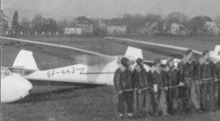PZL Bielsko IS-1
| IS-1 Sęp | |
|---|---|

|
|
| Type: | High performance glider |
| Design country: | |
| Manufacturer: | |
| First flight: |
June 2, 1947 |
| Commissioning: |
1947 |
| Production time: |
1947-1948 |
| Number of pieces: |
|
The PZL IS-1 Sęp ( German Geier ) is a Polish high-performance glider developed after the end of World War II . The abbreviation IS stands for Instytut Szybownictwa (Institute for Glider Flying).
development

The IS-1 was the first glider developed in Poland after World War II. The construction was worked out by Władysław Nowakowski and Józef Niespał. The first flight on June 2, 1947 was short-lived due to incorrectly connected ailerons, but the pilot Piotr Mynarski was able to land the aircraft safely. Further testing was successfully completed and just a month later Adam Zientek took part in a competition held by the Swiss Aeroclub in Samedan with the IS-1 (registration number SP-443 ) and took eighth place. The experience gained at this meeting led to some improvements; the wings were given a larger V-shape , transverse controls and flaps were changed and the cockpit redesigned. Five copies of this version, known as Sęp bis , were built, the first of which was completed in May 1948. Three of these aircraft were entered for the 1948 World Championship; their participation prevented by the cancellation of the Polish selection. For this, the IS-1 was used in the Polish championships in the same year and took the first three places there. Further top performances followed. For example, Irena Kempówna flew with the SP-549 on June 10, 1948 a 100 km triangle at 50 km / h and set a new world record. This was followed on July 23, 1950 by a national altitude record of 5737 m, which was achieved by Tadeusz Góra after Adam Zientek had covered over 232 km on a target flight the day before. Another Polish national record was set on July 23, 1953 by Jerzy Popiel, who flew through a triangle of 100 km at 68.55 km / h.
The IS-1 was used until the 1960s; one of the six built copies with the registration number SP-552 has been preserved and is exhibited in the Aviation Museum in Krakow .
construction
The IS-1 is a cantilever monoplane in wood construction . The fuselage has an oval cross-section and is covered with plywood . The wings have a slight kink and consist of a wooden structure with fabric covering and a front edge made of plywood. The ailerons are also covered with fabric. Behind the main spar there are 15 or 40 ° extendable Fowler flaps and metal flaps on the underside of the wing leading edge. The series models were also equipped with spoilers on the upper side of the wing. The self-supporting tail unit is also made of wood, with the fins covered with plywood and the oars covered with fabric. The chassis is formed by a skid suspended by a rubber hose under the front fuselage and a tennis ball-sprung grinding spur under the rear.
Technical specifications
| Parameter | Data |
|---|---|
| crew | 1 |
| span | 17.50 m |
| length | 7.50 m |
| height | 1.25 m |
| Wing area | 17 m² |
| Wing extension | 18th |
| Wing loading | maximum 20.70 kg / m² |
| Empty mass | 276 kg |
| Takeoff mass | maximum 353 kg |
| Top speed | 225 km / h |
| Minimum speed | 50 km / h 40 km / h with flaps |
| Rate of descent | 1.60 m / s at 100 km / h 2.60 m / s at 120 km / h |
| Slightest sinking | 0.75 m / s at 67 km / h |
| Glide ratio | 27 at 72 km / h |
| Wing profile | Gö 549 (root) NACA M-12 (outer surface) |
literature
- Kazimierz Wojciech Chudzinski: Polish gliders . Volume 1: 1945-1970. Verlag für Technik und Handwerk, Baden-Baden 2014, ISBN 978-3-88180-454-7 , p. 24-27 .
- Martin Simons: Gliders . 1945-1965. 4th edition. Eqip, Bonn 2017, ISBN 3-9807977-3-2 , p. 95-97 .